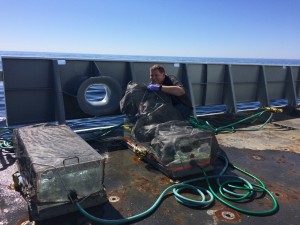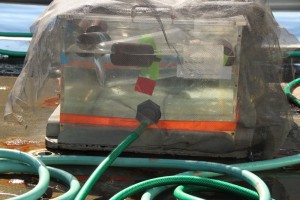How fast is the metabolism of a microbe in the ocean? Today, we set up incubations with seawater plankton to study the metabolic rates of marine microorganisms, specifically to look at carbon and nitrogen metabolism. First, we collected seawater in bottles and placed them in our on-deck incubators (to simulate natural light and temperature). Into each bottle, we added carbon and nitrogen stable isotopes (which are slightly heavier than natural isotopes, and can thus be differentiated from natural isotopes by weight). By tracking incorporation of the heavy isotopes into cells over time, we will determine the rate of their carbon and nitrogen metabolism by seeing how ‘heavy’ the cells become over the course of the day.
To separate metabolic rates of the photosynthetic (light-utilizing) versus non-photosynthetic communities, some bottles were incubated in the dark for comparison to those incubated under natural light. These measurements along with additional information on community structure (through DNA analysis and flow cytometry) will allow us to connect activity with plankton community structure and diversity. In other words, we want to find out: ‘who’ is doing ‘what’ metabolic activities, and ‘when’ (i.e. how fast) are they doing it?
Posted by Bryn and Bradley



